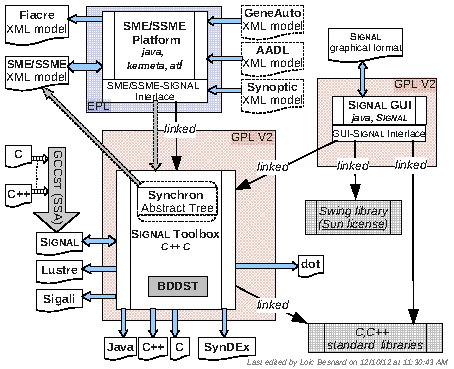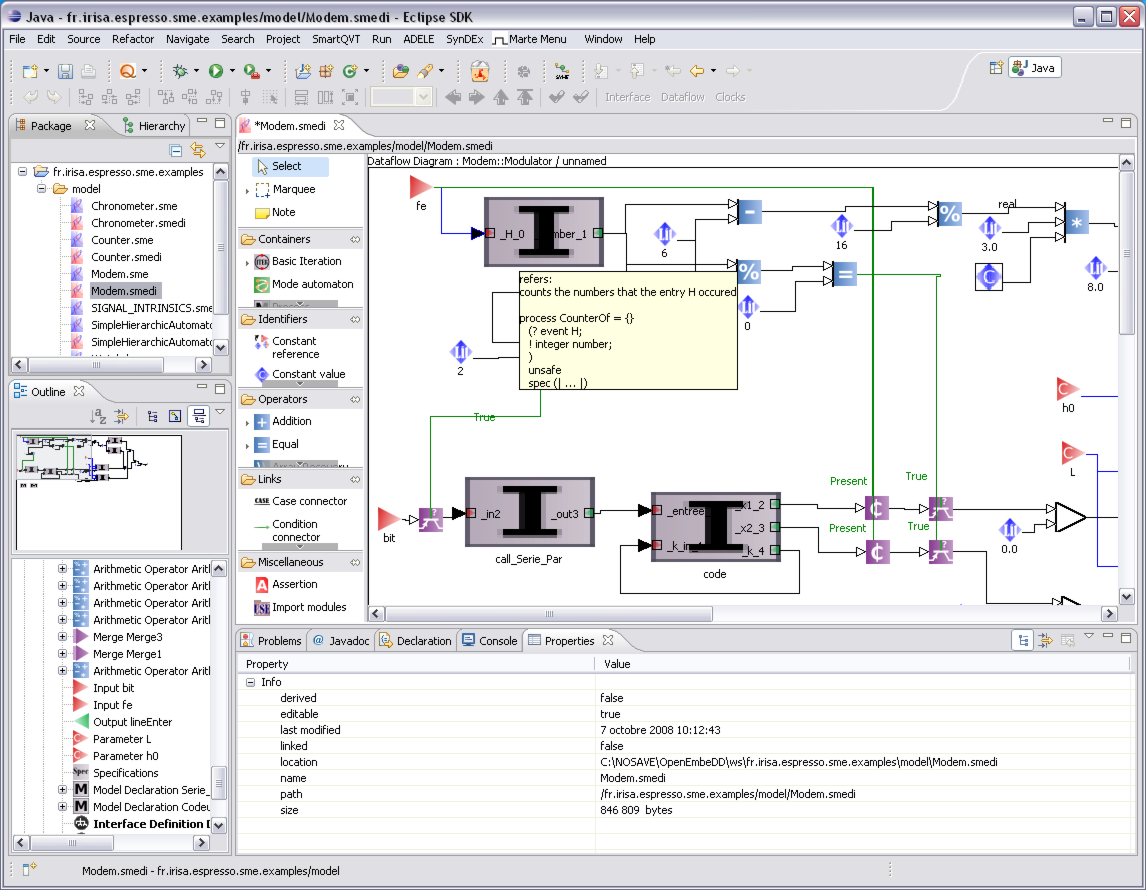Section: New Software and Platforms
The Eclipse project POP
Participants : Loïc Besnard, Thierry Gautier, Paul Le Guernic, Jean-Pierre Talpin.
The distribution of project POP (Polychrony on POLARSYS (POP), an Eclipse project in the POLARSYS Industry Working Group, 2013. https://www.POLARSYS.org/projects/POLARSYS.pop ) is a major achievement of the ESPRESSO project. The Eclipse project POP is a model-driven engineering front-end to our open-source toolset Polychrony. It was finalised in the frame of project OPEES, as a case study: by passing the POLARSYS qualification kit as a computer aided simulation and verification tool. This qualification was implemented by CS Toulouse in conformance with relevant generic (platform independent) qualification documents. Polychrony is now distributed by the Eclipse project POP on the platform of the POLARSYS industrial working group. Team TEA aims at continuing its dissemination to academic partners, as to its principles and features, and industrial partners, as to the services it can offer.
Technically, project POP is composed of the Polychrony toolset, under GPL license, and its Eclipse framework, under EPL license.
The Polychrony toolset. The Polychrony toolset is an Open Source development environment for critical/embedded systems. It is based on Signal, a real-time polychronous dataflow language. It provides a unified model-driven environment to perform design exploration by using top-down and bottom-up design methodologies formally supported by design model transformations from specification to implementation and from synchrony to asynchrony. It can be included in heterogeneous design systems with various input formalisms and output languages.
The Polychrony toolset provides a formal framework:
-
to validate a design at different levels, by the way of formal verification and/or simulation,
-
to assemble heterogeneous predefined components (bottom-up with COTS),
The Polychrony toolset contains three main components and an experimental interface to GNU Compiler Collection (GCC):
-
The Signal toolbox, a batch compiler for the Signal language, and a structured API that provides a set of program transformations. The Signal toolbox can be installed without other components. The Signal toolbox is distributed under GPL V2 license.
-
The Signal GUI, a Graphical User Interface to the Signal toolbox (editor + interactive access to compiling functionalities). The Signal GUI is distributed under GPL V2 license.
-
The SME/SSME platform, a front-end to the Signal toolbox in the Eclipse environment. The SME/SSME platform is distributed under EPL license.
-
GCCst, a back-end to GCC that generates Signal programs (not yet available for download).
In 2013, to be able to use the Signal GUI both as a specific tool and as a graphical view under Eclipse, the code of the Signal GUI has been restructured in three parts: a common part used by both tools (28 classes), a specific part for the Signal GUI (2 classes), a specific part for Eclipse (2 classes). Such a structuration facilitates the maintenance of the products.
The Polychrony toolset also provides:
Dassault Systèmes, supplies a commercial implementation of Polychrony, called RT-Builder, used for industrial scale projects.
As part of its open-source release, the Polychrony toolset not only comprises source code libraries but also an important corpus of structured documentation, whose aim is not only to document each functionality and service, but also to help a potential developer to package a subset of these functionalities and services, and adapt them to developing a new application-specific tool: a new language front-end, a new back-end compiler. This multi-scale, multi-purpose documentation aims to provide different views of the software, from a high-level structural view to low-level descriptions of basic modules. It supports a distribution of the software “by apartment” (a functionality or a set of functionalities) intended for developers who would only be interested by part of the services of the toolset.
The Eclipse POP Framework. We have developed a meta-model and interactive editor of Polychrony in Eclipse. Signal-Meta is the meta-model of the Signal language implemented with Eclipse/Ecore. It describes all syntactic elements specified in (SIGNAL V4-Inria version: Reference Manual. Besnard, L., Gautier, T. and Le Guernic, P. http://www.irisa.fr/espresso/Polychrony , 2009): all Signal operators (e.g. arithmetic, clock synchronization), model (e.g. process frame, module), and construction (e.g. iteration, type declaration).
The meta-model primarily aims at making the language and services of the Polychrony environment available to inter-operation and composition with other components (e.g. AADL, Simulink, GeneAuto) within an Eclipse-based development toolchain. Polychrony now comprises the capability to directly import and export Ecore models instead of textual Signal programs, in order to facilitate interaction between components within such a toolchain.
It also provides a graphical modelling framework allowing to design applications using a component-based approach. Application architectures can be easily described by just selecting components via drag and drop, creating some connections between them and specifying their parameters as component attributes. Using the modelling facilities provided with the Topcased framework, we have created a graphical environment for Polychrony called SME (Signal-Meta under Eclipse). To highlight the different parts of the modelling in Signal, we split the modelling of a Signal process in three diagrams: one to model the interface of the process, one to model the computation (or dataflow) part, and one to model all explicit clock relations and dependences. The SME environment is available through the ESPRESSO update site (Polychrony Update Site for Eclipse plug-ins. http://www.irisa.fr/espresso/Polychrony/update , 2009.). A new meta-model of Signal, called SSME (Syntactic Signal-Meta under Eclipse), closer to the Signal abstract syntax, has been defined and integrated in the Polychrony toolset.
It should be noted that the Eclipse Foundation does not host code under GPL license. So, the Signal toolbox useful to compile Signal code from Eclipse is hosted on our web server. For this reason, the building of the Signal toolbox, previously managed under Eclipse, has now been exported. The interface of the Signal toolbox for Eclipse is now managed using the CMake tool like the Signal toolbox and the Signal GUI.




